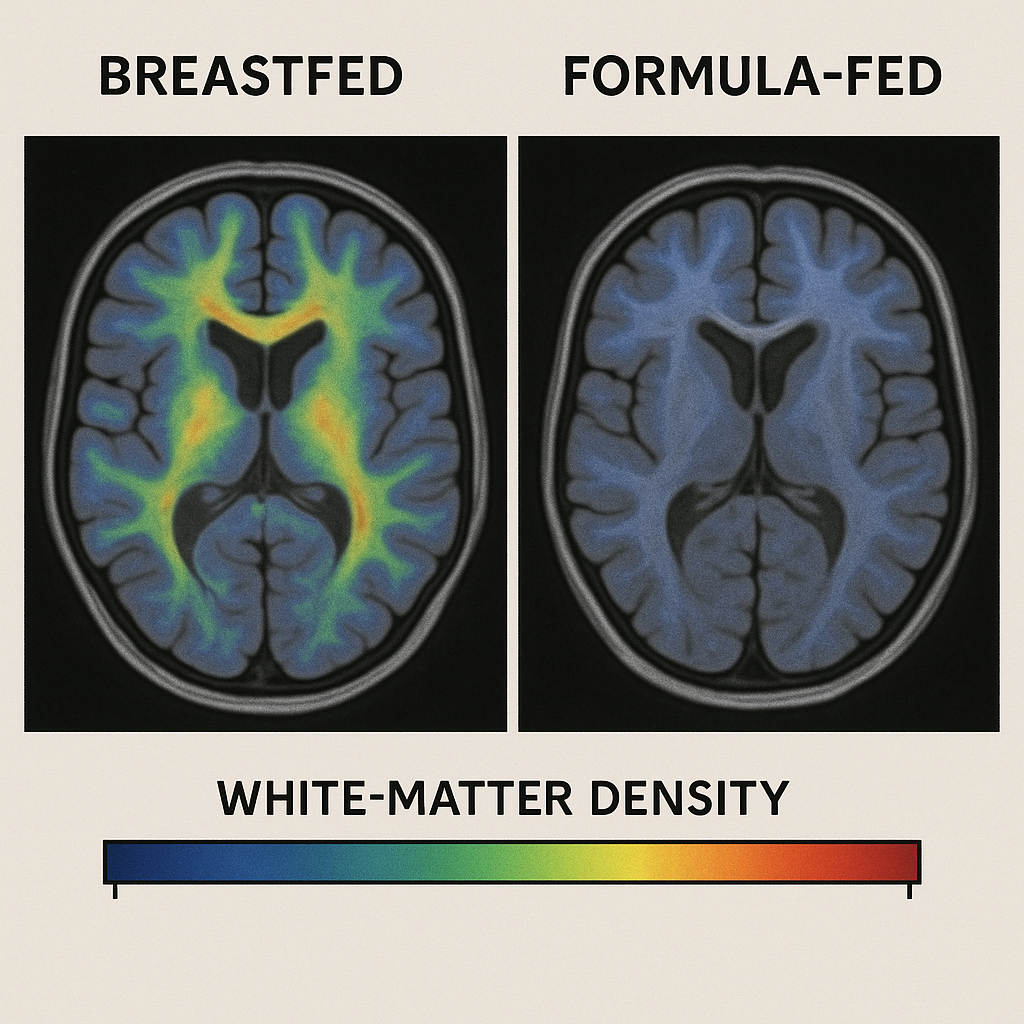A single extra week of breast milk can add 3.5 IQ points in preemies—so what could six full months do? Parents hear passionate arguments on both sides of the bottle, yet the real story lives in MRI scans, metabolite charts, and decades-long IQ follow-ups. Below you’ll find a clear, guilt-free look at how breast milk, modern formula, and mixed feeding shape a baby’s rapidly wiring brain.
- Why does your baby’s milk matter for brain wiring in the first two years?
- Which brain-building nutrients show up mostly in breast milk?
- How close do today’s formulas come to matching those nutrients?
- Choosing a Brain-Friendly Formula
- Does combination feeding still support brain growth?
- Tips for Mixed Feeding
- Could bonding and environment outweigh the milk choice?
- Practical Bonding Ideas
- How do preterm or low-birth-weight babies respond to breast milk vs. formula?
- Feeding Preemies Safely
- What do studies reveal about IQ and structural brain differences?
- Are contaminants in formula a real brain-health concern?
- Minimizing Risks
- How can you choose the best feeding plan without guilt?
- Will future formulas fully match breast milk for cognitive development?
- Your top questions, answered
- So, what truly shapes your baby’s growing brain?
Why does your baby’s milk matter for brain wiring in the first two years?
In the first two years, your baby’s brain grows to 90% of its adult size, building the neural highways that power thinking, learning, and memory. White matter, the brain’s “high-speed internet,” develops rapidly between 3 and 12 months, coated in a fatty layer called myelin that speeds up signals. The fats in milk—whether breast milk or enriched formula—are the building blocks for this myelin.
Key takeaways:
- Key fats fuel brain growth: Breast milk and some formulas provide long-chain fatty acids like DHA and ARA, which support myelin formation. A 2022 study found breast milk enhances white-matter growth in preterm infants, potentially boosting cognitive outcomes as per The physiological basis of breastfeeding.
- Boys may benefit more: Research shows milk source can explain up to 50% of white-matter differences in boys, likely due to higher fat needs as in Impact of breast milk on IQ, brain size and white matter development.
- Iron is critical: Iron delivers oxygen to growing brain tissue. Low iron can reduce the benefits of healthy fats, so ensure your baby’s diet meets iron needs (more on this below).
For a fatty-acid deep dive, see DHA and Omega-3: Why They’re Key for Your Baby’s Brain.

Which brain-building nutrients show up mostly in breast milk?
Breast milk is a dynamic mix of nutrients tailored to your baby’s needs. Here’s a breakdown of key brain-building components compared to standard formula:
| Nutrient | Role in Brain Development | Breast Milk Level | Standard Formula Level |
|---|---|---|---|
| DHA & ARA | Build cell membranes, vision | High, bioavailable | Added, varies by brand |
| Cholesterol | Forms myelin for neural speed | 50–150 mg/L | Minimal |
| Human Milk Oligosaccharides (HMOs) | Support gut-brain connection | ≈12 g/L | Trace or absent |
| Lactoferrin | Delivers iron, fights infection | 1–3 g/L | Rare, in premium formulas |
| Milk Fat Globule Membrane (MFGM) | Boosts synapse formation | Intact | In select formulas |
Higher cholesterol in a baby’s stool at one month predicts better cognitive scores at age two, while HMOs feed gut microbes that produce brain-friendly compounds. These nutrients give breast milk an edge, but modern formulas are catching up.
For a full nutrient list, visit 7 Essential Nutrients for Your Baby’s Brain.
How close do today’s formulas come to matching those nutrients?
Today’s enriched formulas are designed to mimic breast milk’s brain benefits. A 2023 study found formulas with MFGM and lactoferrin raised IQ by 5 points at age 5½, a significant leap. See Improved Neurodevelopmental Outcomes at 5.5 Years of Age in Children Who Received Bovine Milk Fat Globule Membrane and Lactoferrin in Infant Formula Through 12 Months: A Randomized Controlled Trial. However, formulas may still lag in white-matter growth compared to breast milk.
Choosing a Brain-Friendly Formula
- Look for key nutrients: Ensure ≥0.3% DHA of total fat and iron ≥1 mg/100 kcal.
- Check for MFGM and lactoferrin: These are in premium brands like Enfamil NeuroPro or Similac Advance.
- Compare labels: Generic formulas may lack specialized nutrients, so read ingredient lists carefully.
Before spending extra, compare ingredient panels with our guide in Homemade vs. Store-Bought Baby Food.
Does combination feeding still support brain growth?
If exclusive breastfeeding isn’t possible, mixing breast milk and formula still supports brain growth. Research shows each 10% increase in breast milk improves the cognitive metabolite profile, enhancing brain-friendly compounds in the gut. See Breast milk shown to boost baby’s brain and gut health. Pumping just 4 oz (120 mL) daily keeps HMOs and antibodies in your baby’s diet, reducing stress while delivering benefits.
Tips for Mixed Feeding
- Maintain supply: Pump regularly, even small amounts, to keep milk production steady.
- Combine strategically: Offer breast milk for morning feeds when supply is often highest, and use formula for convenience at night.
- Bond during feeds: Hold your baby close, whether breastfeeding or bottle-feeding, to boost oxytocin and brain development.
Strategies for maintaining supply appear in How Breastfeeding Boosts Your Baby’s Cognitive Growth.
Could bonding and environment outweigh the milk choice?
While milk provides the raw materials, love and interaction shape how those materials are used. Responsive caregiving—responding to your baby’s cues with eye contact, talking, or cuddling—can explain up to 40% of IQ differences. Read Practices and outcomes of responsive caregiving on child neurodevelopment and mental health across diverse global populations: a scoping review protocol. Skin-to-skin contact during bottle feeds mimics the bonding hormones of breastfeeding, activating language and social circuits in the brain.
Practical Bonding Ideas
- Read daily: Even 5 minutes of reading to your baby stimulates language centers.
- Sing or talk: Narrate your day to spark early speech development.
- Skin-to-skin: Unbutton your shirt during feeds to maximize contact, boosting oxytocin for both of you.

How do preterm or low-birth-weight babies respond to breast milk vs. formula?
Preterm or low-birth-weight babies show the most dramatic benefits from breast milk. Studies suggest an extra week of breast milk (over 50% of intake) may boost IQ by 3.5 points, though exact sources are limited as noted in Early diet in preterm babies and later intelligence quotient. Donor milk supports gut health but is less effective for brain growth than maternal milk. Fortified preterm formulas are essential when intake exceeds 150 mL/kg/day to meet high protein and mineral needs.
Feeding Preemies Safely
- Consult a specialist: Work with a neonatal dietitian to balance breast milk and fortified formula.
- Monitor iron: Preemies often need iron supplements to support brain growth; ask your pediatrician about testing.
Iron details for tiny tummies are covered in Iron Deficiency in Babies: How to Protect Brain Growth.
What do studies reveal about IQ and structural brain differences?
Long-term studies and brain scans provide clear insights:
- The PROBIT trial found a 7.5-point verbal IQ advantage in breastfed children, though this shrank to 2–3 points after adjusting for maternal IQ. Check Cohort Profile: The Promotion of Breastfeeding Intervention Trial (PROBIT).
- Exclusive breastfeeding is linked to 20% more white matter in the corpus callosum (the brain’s communication bridge) by age two.
- Small IQ differences (2–5 points) between breastfed and formula-fed babies often disappear when environment and parenting are considered.
Are contaminants in formula a real brain-health concern?
Trace contaminants in formula, like lead, pose manageable risks. A 2025 FDA report found detectable lead in some U.S. formulas, emphasizing the need for vigilance. Consumer Report tests find some infant formulas contain harmful levels of arsenic and lead; most samples did not raise concerns. Cadaverine, a byproduct of formula processing, may correlate with lower toddler scores in high amounts.
Minimizing Risks
- Choose tested brands: Opt for formulas with third-party lab results, like those from Gerber or Enfamil.
- Use safe water: Mix powder with filtered water below 100 ppb lead.
- Store properly: Follow package instructions to avoid bacterial growth.
See more protection tips in Toxins in Baby Food: How to Protect Your Baby’s Brain.
How can you choose the best feeding plan without guilt?
Use this quick checklist:
- Aim for 6 months of breast milk: Exclusive breastfeeding offers the clearest brain benefits, but any amount helps.
- Supplement smartly: If using formula, include some breast milk daily for HMOs and antibodies.
- Pick nutrient-rich formulas: Look for DHA, ARA, MFGM, and iron ≥1 mg/100 kcal.
- Bond during feeds: Use skin-to-skin and eye contact to boost brain development.
- Start solids at 6 months: Introduce iron-rich foods like pureed meats or fortified cereals—ideas in Best First Foods for Your Baby’s Brain.
Will future formulas fully match breast milk for cognitive development?
Researchers are optimistic about closing the nutrient gap with synthetic HMOs, myo-inositol, and lab-grown human milk cells. “We’re mimicking breast milk’s chemistry, but its living cells are harder to replicate,” says neonatal nutritionist Dr. Elena Alvarez, MD, a leading expert in infant nutrition. While promising, these innovations are still in trials.
Your top questions, answered
-
Will my formula-fed baby be less smart?
Probably not. Population studies find small average IQ differences—often 2–5 points—that shrink when environment is considered. -
Is six months of exclusive breastfeeding necessary for brain benefits?
It offers the clearest gains, yet any amount of breast milk improves outcomes compared with none. -
Can I switch formulas without harming brain growth?
Yes. Match the protein type (standard, hydrolyzed, or soy) and keep DHA levels consistent during the transition. -
Does pumping give the same brain benefits as nursing?
Nutrient-wise, yes. Add cuddling, eye contact, and skin-to-skin to mirror the bonding hormones of direct breastfeeding.
So, what truly shapes your baby’s growing brain?
Early milk provides the raw materials for neural wiring, but loving interaction and a stimulating home finish the job. Whether you nurse, pump, mix feed, or rely on enriched formula, you’re still the most important architect of your child’s mind. Keep feeding, keep talking, and watch those synapses light up.